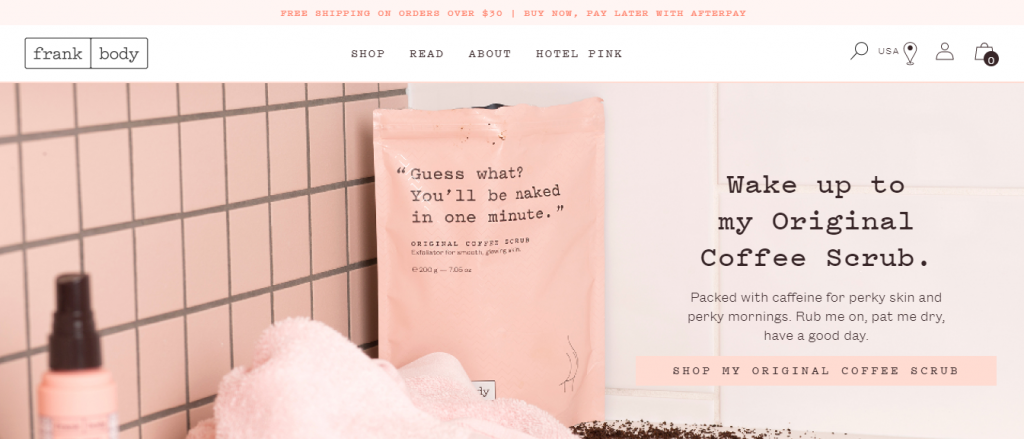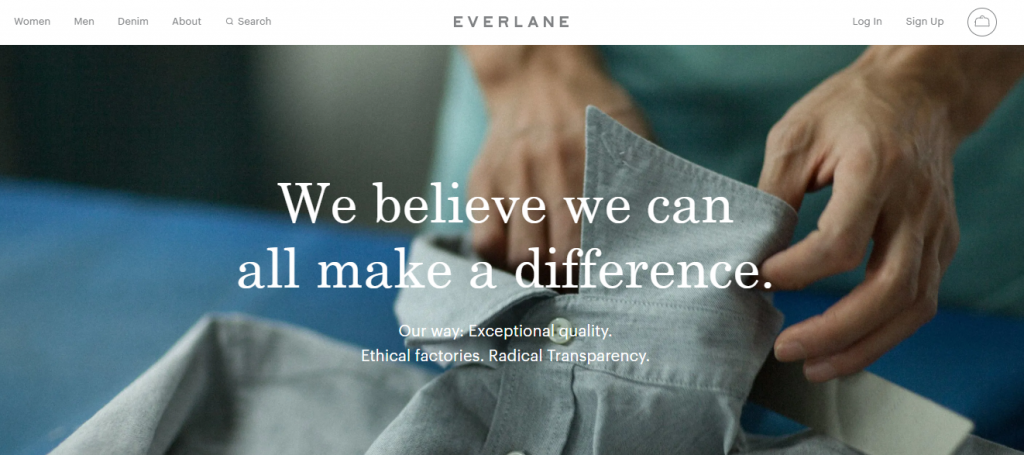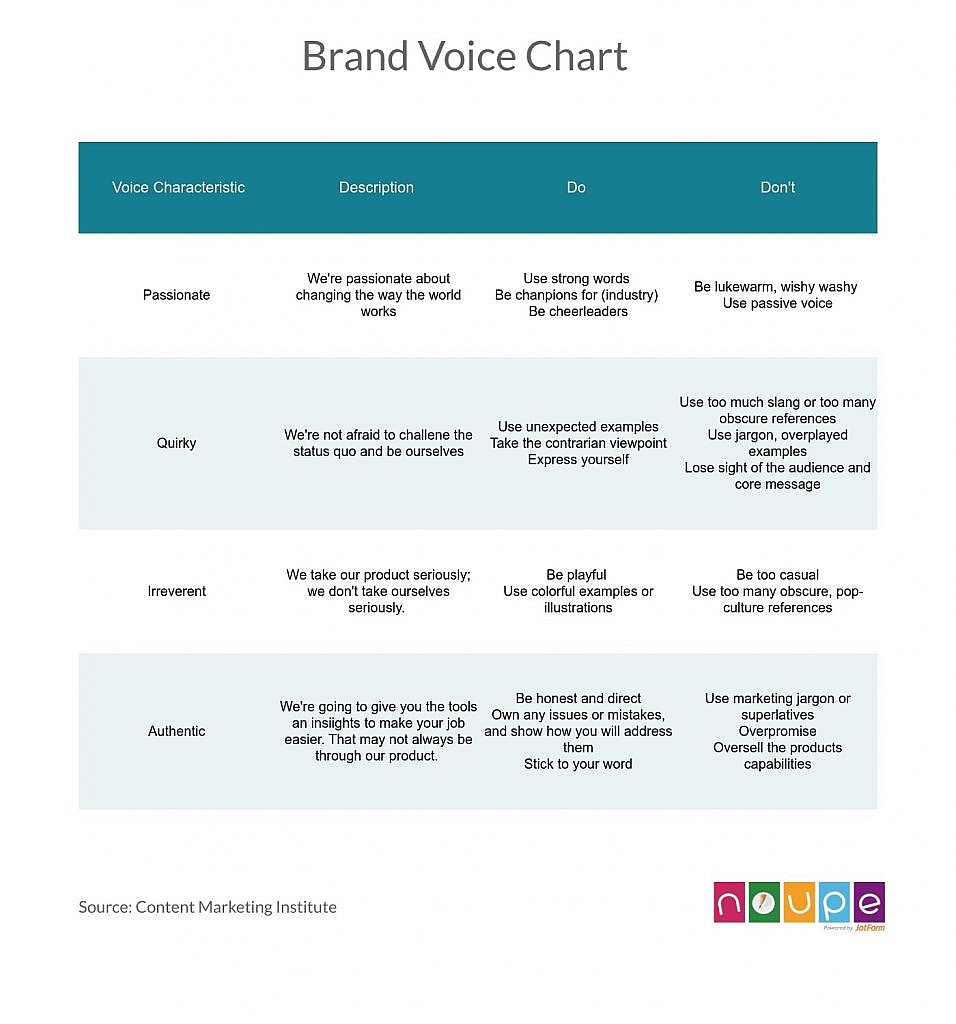How to design a brand tone that appeals to your audience

How impactful is a well-designed brand for growing your business?
It can be the difference between connecting with your audience and getting lost in the massive amount of noise in the world.
Every year, the internet gets more and more crowded.
In 2020, we’ll produce roughly 2.5 quintillion bytes of data every day. Much of it is the noise that makes it hard for your potential customers to find the signal your brand is putting out.
- 500 million daily Tweets
- 23 billion text messages sent every day
- 77,760,000 links are shared on Facebook every day.
- 1 billion hours of video are watched on YouTube every day
- Etc.
What will separate you from the pack, attract readers, listeners, and viewers, while growing your business?
The answer is simple – a distinctive brand tone that’s memorable and aligns with the audiences you’re trying to draw. In this guide, you’ll learn the nuances of a unique brand tone, how to define your own, and tips to implement it in your messaging.
What is a brand tone?
A brand tone is the embodiment of your brand’s personality and values. It’s the way you communicate your message to the world as opposed to what that message is.
For example, a brand’s message could be that everyone is special. Many people have been hearing it since they were born. What’s unique is how you communicate that to people.
Instead of saying “you’re special,” the brand may say “you have a unique gift the world is waiting to receive. Only you can give the world that gift and once you do, everything will change.” In both cases, the brands are saying people are special, but one is much more memorable.
Your brand tone encompasses the words you use, which ones you ignore, how you put them together, how energetic your messages are, etc. This is often associated with spoken language like when you’re on a podcast but for businesses, it’s usually applied to written communication.
Your tone of voice will define how your write website copy, the website design you choose, the way you post on social media, emails, packaging, and more. A great example of this is Innocent drinks. It has a well-defined brand tone that’s visible on its social media accounts and packaging.

You can view more of them here

If the amount of engagement is any indication, the brand is doing something right.
The role of brand tone in your brand voice
Your brand voice and personality are constant and don’t change but a brand tone is nuanced and evolves. It’s tailored to fit the medium, the audience, and the subject.
For example, if there has been a tragedy, your upbeat tone may be dampened to show respect. That doesn’t mean your personality or voice has changed, it just means your brand understands the situation and is responding accordingly.
It helps set you apart
Your overall message can be similar to others but the way you communicate that message comes down to the brand tone. It ensures no one else sounds like you so your customers and prospects recognize your messages.
Think about when you’re chatting with a close friend, family member, or partner. If someone starts to chat on your behalf, the people close to you can tell. Why’s that? The nuances that make you unique are missing and something is “off.”
You don’t have to be irreverent or abrasive to stand out. You just have to be different from what’s available. Frank Body is able to do this well through its website and packaging.

It communicates healthy radiant skin but does it with a tone that’s different from any other brand. It takes on the guise of a man. The inner voice inside of a woman’s head that’s at times masculine and calls her a babe while encouraging her to be confident in her skin.
The unique brand tone coupled with savvy marketing chops resulted in over $20 million in revenue within three years.
It builds trust
If repetition is the father of learning then familiarity is the father of trust. The more familiar you are with something, the easier it is to process it mentally. The easier it is to process, the more likely you are to feel at ease and trust it.
This happens in all humans because of a tiny section in our brain commonly known as the lizard brain. It’s responsible for the fight or flight reaction. If your brand is constantly jarring customers and prospects it’s interacting with then it may cause stress.
A stressed mind will try to relieve the stressor and in this case that results in less attention for the brand. This isn’t an issue for an organization with a consistent tone and message. Let’s look at how to design it.
How to design your brand tone
There are many steps required to get your brand tone right and it starts with the people you’re interacting with. Once you understand them, you can start to look inward to build out a compelling brand tone.
Get a deep understanding of your audience
This is the most important step because if it’s skipped, you’ll have no idea what appeals to your audience. At most, you’ll sound similar to everyone else in your space.
Remember Frank Body? The founders are part of its target audience but they still spent time researching to get the brand tone right. Here are a few ways to research your audience.
Audience surveys
If you already have a sizeable audience and customer base or can access them, surveys and polls are a great place to start the research process. Ask questions to understand how they perceive your brand and the things they find important. Here are a few questions to get you started:
- What do you find important in an X brand (x is the type of brand you have EG clothing, software, etc.)?
- How would you describe our brand?
- Is there anything you think is missing from our brand?
- Name three of your favorite X brands. Why do you like it?
- What, if anything, would you consider a deal-breaker in an X brand?
- If our company was a human, what kind of person do you think it would be?
- What social issues are important to you?
Beyond designing your brand tone, these responses deliver insights that you can incorporate into your marketing workflow.
Interviews
Another way to research your audience is to hold in-person or phone interviews. This is a great option because they give you the opportunity to probe deeper. If someone tells you something is missing from your brand, you can ask them why they feel that way or how it would change their perception.
Ask similar questions as you would in a survey but make sure you follow up with each answer. After about 10 interviews, you’ll have a clearer understanding of your audience, what makes them tick, and what they expect from you.
Social searching
The last research method focuses on understanding what your customers do on social media, forums, and even their own websites. Look up a few of your customers on the internet and follow them on social media.
- Who are they as individuals
- What other brands are they following
- What kind of content do they share
- How do they write their social posts (playful, irreverent, formal, etc.)
- What causes they champion
Taken together, these research methods will give you a deep understanding of your audience and inform other decisions you’ll need to make.
Decide on what you stand for and the values you’re communicating
The audience research exercise helped figure out who you’re serving and the values that matter to them. Now, it’s time to align your company values with that.
For example, your customers may care about specific environmental causes like global warming or ethically produced raw materials. You can align with them by making a commitment to using green vendors and technologies.
Core values
When you practice radical transparency, 94% of consumers are more likely to be loyal. That’s powerful. Transparency starts with defining your core values and continues by communicating them often and consistently.
One of the core values of Everlane is radical transparency.

It shows in everything they do. I’m not saying you should be radically transparent just to get more eyeballs on your content and business. Instead, be clear about what values guide your decisions and brand tone.
Ask the following questions to help define those values:
- Why did the company get started?
- What’s unique about the company (people, processes, marketing, products, etc)?
- Who do you serve?
- What pains do you solve?
- What causes do you champion (even if they’re not directly related to your business)?
- Why should or do people trust you?
These questions allow you to refine your brand tone by making sure what you say and how you say it is consistent. Here are a few examples to inspire your core values.
Define (or refine) your mission statement
A mission statement is meant to be a guiding light for people within and outside of an organization. Now that you’ve defined your core values you can align the mission of the company with them. When done properly, all your marketing collateral and messaging will work to push that mission forward. A mission statement has three components.
- Who you are
- Who you serve
- What you do (or are going to do)
Acme Inc. is a software company that makes cutting edge customer experience and conversion optimization tools (who they are) for small businesses (who they serve) that makes it easy to better understand their customers and turn those insights into more leads and revenue (what they do).
In the example above, Acme Inc. creates cutting edge tools for small businesses to make their work easier. Since it serves small businesses, it may not need to as formal. As a technology company, it can also get away with being a little geeky.
Define your brand tone
Defining your tone is the fun part – and the hard part. How do you boil your brand down to its essence in a way that is easily understandable by team members and customers?
It needs to be simple enough for everyone in your organization to understand but nuanced enough to stand out from the crowd. Here are a few ways to make that a reality.
Describe it with a few adjectives
According to Margot Bloomstein, choosing a few adjectives to describe your brand will make your messaging clearer and more powerful. It’s the beginning of a messaging architecture that allows you to push the qualities you want to be associated with your brand to the forefront.
She goes on to describe a simple exercise. Compile a list of 50 – 100 adjectives that could describe organizations in your industry. More importantly, adjectives that could describe your business. This list should then be divided into:
- Who we are
- Who we aren’t
- Who we’d like to be
I’ll describe another exercise in a moment but for now, focus on who we’d like to be and group the adjectives that fall under this category into closely related groups. Here’s an example to illustrate:

From the example above, you know the brand wants to communicate trust and quality, innovation, and being socially conscious.
Don’t’ go through this exercise then abandon your messaging hierarchy on an old hard drive somewhere. Actively share this knowledge with your team because it’s there to serve as a reference point for all of your messaging.
We are this but aren’t this exercise
After you’ve gotten your messaging hierarchy right, it’s important to take those same adjectives and define how you want to use those qualities. For example, there’s a thin line between irreverent and rude or playful and silly.
The following exercise is simple but it helps avoid those problems when creating landing pages, content, marketing campaigns, infographics, and other forms of messaging.
We’re ____ but not ____.
Take three or four of the adjectives that describe your brand the most and go through this exercise.
We’re informal but not sloppy.
We’re knowledgeable but not cocky.
We’re authoritative but not overly serious.
It may take a few tries to get it right so don’t think it needs to be perfect in a day or two. Once you’re done, move on to the next step – a brand voice chart.
Create a brand voice chart
A brand voice chart is a simple representation that helps people understand how the adjectives you’ve used to describe your brand should be used in your marketing.

The left column is the adjective used to describe your brand, the one next to it is a short description, and the two on the right are what you should do and shouldn’t do to achieve the right outcome.
Don’t hesitate to ask for help here. The brand voice chart and the messaging hierarchy are important documents. They evolve with your business and should be revisited often.
Audit your brand voice and tone
We’ve covered a lot of ground in this guide. At this point, you should be crystal clear about what your core values are, what your brand stands for, and what doesn’t apply to you.
The last step is to audit what you currently have and implement changes to ensure your brand tone and voice are consistent. This is a straightforward process.
Go through your different assets which may include:
- Blog posts
- Ebooks
- White papers
- Landing pages
- Product pages
- Video content
- Audio content
- Print material
- Signage
- Etc.
Note what you’re already doing that aligns with your updated brand tone and also note what’s missing the mark. How can you improve what you’re already doing to better align with your values, voice, and tone?
Be as comprehensive as possible with this process because people will continue to find your content for years to come. You don’t want a situation where part of your messaging has the right tone and the other part doesn’t.
Over to you
Your brand tone is an important consideration but it’s not made in a lab somewhere. It requires input from people within and outside your organization.
- Start with your audience to understand what they appreciate and their values
- Decide on your own core values and mission statement.
- Define your brand tone by going through the exercises outlined in this post
- Audit your current assets and update to reflect your newly defined brand tone
Repeat this process as often as needed to ensure you have a consistent brand that stands out from the crowd.
Featured image by Andrea Piacquadio

Very Informative! thank you…..
Hello.This article was really interesting, particularly since I was investigating for thoughts
You have explain all the points very well I have learned a lot from this article. Keep it up Thanks for sharing with us.